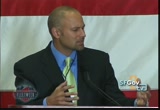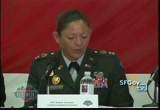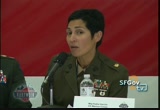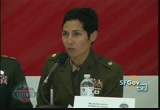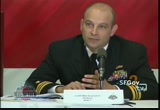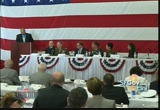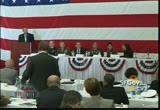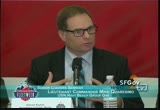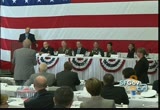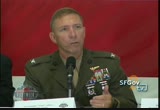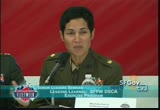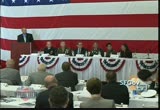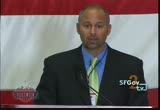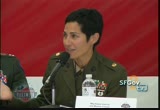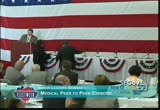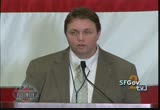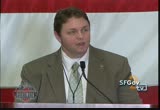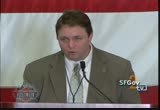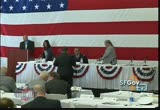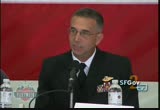tv [untitled] December 11, 2012 11:30pm-12:00am PST
11:30 pm
orientation, although that's very helpful, we're not that familiar with san francisco, where the hospitals are, where the priority routes are, but we also need a quick orientation what the priorities are. where is the focus of effort so we can orient ourselves and our capabilities towards that. second thing we need is to understand the intent. what is the priority, where are they and that also keys us to what capabilities we might be able to focus on. of course the third thing we need to know what the resource shortfalls are. that will allow us to determine what kinds of equipment we need to put towards that. but what i saw in the exercise was a good information flow and an atmosphere of a team effort at the location at ocean beach. >> thank you. thank you, all. when we have an vent in the
11:31 pm
future and we know it's going to happen, we just don't know when, i sometimes tell my team we're one day closer to the next disaster. i don't know when it's going to be, but we're one day closer. when that happens it's unlikely that the people we exercised with are actually going to be the people who are responding. so knowing that, what are the top 3 things that you might share, your elevator speech, if you will. rob mentioned institutional knowledge. what do you want to take and give to someone else when they come to san francisco? and this is for our military participants. captain houston? >> my recommendation, dod element coming into a city incident, is, one, bring a list of your communications capabilities, your frequencies and documented in its capabilities, not necessarily the acronym of your branch. we came in with our hf radios and
11:32 pm
lucas took that information, he understood it and put it on to his ics form. so that's the no. 1 priority that i would say to bring in initially. 2, i would say understand the primary situational awareness. in the military we call it a pay plan or primary alternate. what i would say is understand what your operators want to see as their primary form of communication and command and control. 3, i would say communicate in the clear. and with that what i mean is identify your equipment by capabilities, and also the radios need to be unencrypted single channel and plain text, which is something we don't operate a lot on in the battlefield, but this isn't the battlefield, this is home. so that's a new communication change as we move forward in supporting our civil
11:33 pm
authorities. >> okay, i understood the question perhaps a little bit different. what would we tell, you know, personnel coming in for another iteration of this drill. and for me, no. 1, is of course military folks do this a lot, is to read the after action. i think a lot of work, time and thought has been put into that. i think one of the best conferences that i've attended was the very last one in september, which was the after action. i know jill raycauft and lucas ekrode have taken this to heart so we do have a road map for next year. read the after action. no. 2, captain houston mentioned it already, it's think open architecture. i noticed that departures for the military, our communication is
11:34 pm
encrypted, when you are doing humanitarian assistance or even here on national soil, you need to be able to communicate. so that was a take away, probably unencrypted plain text communication. think open architecture. the last one that i have is definitely familiarize yourself with disca, it's coming to the forefront, communications quite specifically. that means knowing what civilian authorities utilize in terms of frequencies and wave forms and that's not something that we do every day as communicators. so it provides an opportunity for a more well-round ed case and i certainly got into that territory this year. thank you. >> there's definitely 3 things i'm going to hit hard with my relief. first is understand that c2 piece because it is
11:35 pm
complicated. we don't understand under that structure normally. it's very important that my relief understands or any disca planner understands that c2 piece. second is understand the ics and then take the time to get the training. we put together a pretty robust training plan in preparation for this. we did the fema online course, eoc course at nasne, hadr course, trained with cal fire, take the time to take that training. it's tough to fit it in but it's important to fit it in and it will make us more effective. we did an exercise back in may in preparation for this and developed a pretty detailed concept of operations. we built load plan, timelines,
11:36 pm
spare parts lists, we really got into the weeds, thinking about the second and third tier effects, so i want my relief to understand that and i want him to know where that plan is so he can pull it right off the shelf if this ever happens and be ready to respond quickly instead of trying to figure this all out when we need to be getting underway. >> i'll boil mine down into just one, and that is i will pass to my relief to continue to support events like this and look for opportunities to continue to learn how we best in the military can integrate with our civilian and federal contemporaries to be prepared for an eventuality that we hope will never come, but we certainly should be prepared for. so the one thing i'm passing on is keep the momentum.
11:37 pm
>> thank you, all. one other benefit that was cited in the after action review and also was mentioned today is the chance it meet someone else from the other agency. we also heard a lot about training, understanding ics, understanding dsca and that's defense support of civil authorities. it's the guiding principles for how our armed services are going to support civilians when something happens. and i think those are common across a lot of the themes you are going to hear today and throughout the weekend. so i'd kind of like to take those two off the table because they are sort of gimmes and put it to you, what are the things you told your boss about this exercise and what is something that for next year you would like to see us do? michelle, if you'd start us off. >> so i think that the major task for next year when we do
11:38 pm
this communications drill, which i hope we continue to do, and i think you mentioned this earlier, we assumed that all of the city's primary communications were online and operational. we used 800 megahertz push to talk radios here. we assumed that system was online and operational and i think next year it would be a really good exercise for us to pull that communications capability out of the picture and use military assets. i think we're going to have a lot of lessons learned out of that activity and it would be a good exercise for the city personnel to understand how they would operate using the military aid. >> i think one of the things that i wrote in my after action report it my boss was about training. we actually have an acu1,000 type capability in pendleton and that is a piece of equipment that bee don't train with routinely the
11:39 pm
expeditionary folks. i think there is an opportunity in training, it's great when marines get to see the gear and do that type of cross banding we spoke about. civilian authority operates in 700-800 megahertz range. we know fires happen a lot and we're often asked to support so training is a big recommendation i make. >> what i'd recommend is practice makes perfect and flexibility is required. so with communications being flex i will and you have to practice. we did some training events with the acu's in order to teach other agencies how to cross band the radios but it continues to grow. next year there will be a new version of the acu's, which does cross banding of radios. as long as we stay engaged we keep communicating and we keep working to the and keep the lines of communication open, i think the exercise will go excellent as we grow. >> i told my boss that
11:40 pm
communication's at the heart of everything. the stronger we are with our communication abilities the more success we will have going forward. not to beat a dead horse on this, but the common operating picture was really the point i brought back to my boss that i said would solve the shared mission issue, would solve the lexicon and slang issues and bring everyone to the same table understanding where we're going and to develop a few tools not only sort of specific to the department of public works to show our piece, but then more broadly to the city that we can bring to the incident and share, regardless of who's there, what part of the department of defense or other entities that are out there that can come to the table and hit the ground running as a result of that tool. that was my biggest take away and that's my main recommendation to my boss. >> i was fortunate, my boss was there. so i think we both shared the concept that interoperatability is the key. we need to continue to work to ensure that we have
11:41 pm
interoperatability with the federal, state and local governments and next year i think we'll take this exercise to another level. i'm not sure what that's going to be, but between now and then we will be working to ensure it's successful. >> i told my boss that based on all the planning we did, the training we did, the exercise specifically functional exercise specifically, we're far better prepared to respond than we were 6 months ago. i think we were prepared then but as a result of all those efforts we're that much more ready. three things i broke down in my aar, planning, the office of emergency management, there's something like 19 entities that participated in this exercise. that's an overwhelming amount of different agencies to bring together for one agency. we do a lot of training, we run a lot of drills, but it's not on that scale where we're working with
11:42 pm
19 different people or entities. execution, extremely smooth. the integration piece was key and finally the way ahead, so what's next. well, we got to continue to refine our standard operating procedures, continue to refine the con op, continue to make recommendations and continue to track those lessons lerbed. for my boss, a lot of the work starts when the exercise is over. it's not over just when the exercise is over, you have to continue to push that through and make sure that those lessons learned get incorporated into the plan. >> i think commander carismos said it well. a lot of the planning we do comes after the exercise. that's when we have a chance to test things out and see what doesn't work. we would prefer to find that out now than when the incident takes place. i think the panelists have given us a lot to think about but i'd like to open it up to
11:43 pm
you. what questions do you have for any of our command and control or our communications experts? if you have a question, please put your hand up and we have a microphone we can run around. jill? >> i fresh very much all the comments that were made and it's impressive what you have done and learned. i have a question. when you are operating somewhere and you are communicating with each other and you are getting information and a lot of it is action oriented, you are really operating in a sea of information and communication in the sense that everybody these days can find out stuff, communicate. a lot of the information they get is wrong, bad things can get communicated. how do you go about interacting with this sea
11:44 pm
of information that's around you and trying to be sure that it contains what's accurate, is helpful rather than harmful to your efforts? >> coordination and documentation of knowledge management, usually done through the operations. information that flows in can be captured, it's easier for the operations personnel to make command and control decisions. i think we used web eoc as that emergency management piece for this exercise. >> i would add from my experience, both in combat operations and in hadr's, never believe the first report. information typically self-corrects over time and it's incumbent upon us to verify before resources are
11:45 pm
allocated. so absolutely, sir, it is a sea of information coming from very far and wide sources and it's very important for us to bring in all the information and ensure that it's filtered. and as i spoke before, it needs to be filtered into buckets of emergencies, priorities and ra teen information and that truly is an art. but it has been my experience that as reports come in, they are typically not exactly correct but they do self-correct over time as more information resources are put against it. >> are there other questions? >> i'm interested in your use of social media, whether it be tweeter or cloud sourcing or other techniques that you use to gather information quickly and from a wide variety of on scene participants. >> so the use of social media
11:46 pm
to get situational awareness? >> i know there was the topic of discussion in many of our planning meetings and i think even mr. rob dudgeon at one point mentioned that's how people know what's happening, communicating via their cell phones about what's happening. but i personally think that has a limited application, right? so when cell phone towers are not working any more and we i think had a blackout in san diego last year, last fall, cell phones weren't working. so social media i think can help and may work and you can get through populations that way, but i think it will be important to know that also has its limitations and at one point that goes. that's when you need to thank back-up
11:47 pm
communications and that's where the military can also be a force multiplier. >> from the department of emergency management perspective, we have a phenomenal social media team that gets information out over multiple channels using facebook and twitter. we also have an alert sf system that we use that disseminates information just about the helicopter landing during yesterday's exercise, so we have those tools in place and just for your point, i think that would be a really great thing to add even to the communications drill, we know now how to communicate internally at the incident but how do you share that information and get it out. i think we could use some of those forms of exercise we use day-to-day as part of the exercise. >> i think the concept of emergency is also relative. if members of the armed forces are getting called out, that is a
11:48 pm
big emergency. for someone who is commuting to work in the morning the fact there is no electricity in one area of the city so traffic is going to be horrible and they can't get their child to day care, that is an emergency to them. that's where we use social media so we can find other things that may be happening in the city so we can send it out to our followers, also, as michelle mentioned, preemptively let others know here's what's happening with your day. >> i heard you guys mentioned you used your blackberries and cell phones to communicate with each other during the exercise. at a point where we have dsca, there's a high probability, i would think, we wouldn't be able to did that. was that folded into your planning perhaps for the future to say, hey, we're not going to use
11:49 pm
that stuff today but just use the stuff the military brings to the table. >> we used 800 megahertz radios to report from ocean beach back to the department operations center in public works and we just jumped to that point. my staff know how to use radios, the military knew how to use them, we sort of went into our groups, it was a little cumbersome at times, hard to hear, but they were solid, we knew they were going to be working. i think for the most part it jumped. honestly we didn't have a very detailed conversation about cell phone ability or inability, but it seemed to work. that was our back-up plan and i felt it worked quite well. >> i think that's a very good point and i think what you are probably saying is, you know, maybe we should consider very severe environments in case of a disaster which personally i think that's how we train and
11:50 pm
probably most of your environments. maybe you want to start from a place of more limitations rather than less and one of them is not doing that kind of coordination via cell phone. again, i think this was, last year there was a table top, this is the first time we're actually doing a drill. there's reason for growth and as bijon said, maybe next year we are meshing xhapld and control so command and control is done over the exercise com link and keeping it separate. i think the point is well taken that the recommendation i made, i think we can introduce more rigor into the execution of the com drills next year. >> any other questions? panelists, thank you very much, i appreciate it. let's give them a big round of applause.
11:51 pm
(applause). >> something that took place yesterday was our medical exchange. rob is going to give you a summary of how that went and at the same time we're going to bring up some additional panelists who will give us their perspective. >> so we're going to do a little bit of a hot swap here to keep the show rolling. while we seat the panel i'm going to introduce them but focus on medical. this just started up last year formally, but i have to say it really started in 2010, the idea of how do we highlight the medical because for those who don't know my history, i'm an old paramedic so this kind of comes naturally to me. in 2010 we were aboard the macon island, one of the things i was fascinated with as were the attendees was the hospital space. there were a bunch of
11:52 pm
tours that took place there. last year the idea, it wasn't my idea and i wish i could claim it but i can't, the idea to do a medical peer to peer exchange between the military and the hospital providers here in town. so it was arranged where practitioners and executives, so practitioners and their bosses, to could come out and see the shock trauma platoon and see the capabilities of the shark and see what the military brings to the table in terms of medical. it was a huge hit, to be perfectly honest. it was well received. the medical community here in town was very impressed, really wanted to see more of it, and this year we grew that a little bit. it took flight, literally. it started with looking at rather than be a show and tell, like most things with fleet week, it
11:53 pm
started with, let's make it more than an air show. then it led to let's get on the ground and do hands on with our middle managers. the same thing is happening in the medical exchange program. we have gone from a show and tell basically of this is what we have to offer, to this year of actual demonstration of that in a more austere environment and we tried to fit that in, how does it fit in with what we're doing in san francisco and the bay area with medical planning. so yesterday we had an opportunity to go out and see a shock trauma platoon set up on ocean beach, had them running demonstrations and asking questions of the doctors and nurses there. we also saw a landing craft on the beach. yes, it can bring a
11:54 pm
tractor, it can bring personnel, it can also evacuate patients. it can also bring resources that we otherwise wouldn't be able to get into the city. general spies has said it many times, they have the ability to go around, over, i think through was one of those as well, any of the obstacles we find in our way. that's a resource we in san francisco really have to capitalize on. as i look at all these things, frankly i just was talking to somebody this morning, this is like the toy store of resources for me. when you sit on this ship, you look around, yes, it's a ship, it carries helicopters. it is so much more than that. it's a platform that does so many things. it's like your i phone. you ask it what you want it to do and there's probably an app for that. and that's the beauty of it. it's a multi use platform when we started to engage these kinds of resources. so this is my one chance today
11:55 pm
because this is the last you are going it hear from me today, i get to thank the team that put all this together. i wanted to take a moment and give a shout out to jill raycauft and lucas eckrode and dijon, those are the key players that made this thing happen for you. they are the ones that put together the exercises, they were the ones that were here to 10:00 last night getting this thing set up. in particular for this next one i want to join ben tanner. ben joined the facility to work on cardiac care survival. i said, ben, i have a project for you. i'm not sure if he's forgiven me for assigning him yet, but he did a great job. anybody who was out there, saw
11:56 pm
it, experienced it, we were able to see the shock trauma platoon, see the landing craft coming ashore, we put medical personnel into helicopters provided by the marine corps, flew them down to moffatt where they had an overview perspective how things work from a military perspective, they saw a c130 outfitd for patient transport by the national guard. they got to see the national guard's capabilities down there, the coast guard's capabilities. they got experience of what the marine corps has to offer. it was the smorgasbord of mill capability. as we contemplate the idea of medical surge and how do we deal with a thousand people in a hospital parking lot, we have to be creative. the only way we can do that is we have to know what are the options out there, what are the game pieces, what's the apps in the
11:57 pm
apps store? what can we ask for? by understanding some of these capabilities and looking beyond the obvious i think we're going to be able to develop some really cool medical surge plans and capitalize on the partnership between dod and the civilian world and i don't want to discount the other partners because this happens, this comes up every year and i have to say that it comes up every time we get lectured about there's the state, the state has resources, the feds, the other federal partners, they have resources, absolutely. when i say dod, please don't take it the wrong way, i'm encapsulating the entire family. when we throw a party, we go big. we don't do little things very often in san francisco but every hundred years or so, we do it in a big way and you know what, the bay area is overdue. we're going to need every player at the table. that's one of the best things we do with these
11:58 pm
exercises is getting to know what's available. with that i will ask the medical panel to come up so we can get the next part started here. >> thanks for that introduction, rob. as we started our last panel with, what i'd like to do is have our panelists introduce themselves so you can again understand their perspective and the lens they were looking through when they went through yesterday's medical exchange. >> my name is nadine baba, i
11:59 pm
am with the san francisco department of public health, unfortunately dr. karen holbrook couldn't be here. i work in the emergency preparedness section and our section is responsible for medical surge events in the city. yesterday's exchange was really helpful in forwarding that planning ?oo ?a i'm greg jones, i'm the fourth surgeon for the marine expeditionary brigedand i'm representing the excellent sailors who were responsible for setting up and operating the shock trauma platoon. >> controls ingels, california national guard. i'm one of the airmen and soldiers, almost 21,000 strong, that answers the governor's mission.
65 Views
IN COLLECTIONS
SFGTV2: San Francisco Government Television Television Archive
Television Archive  Television Archive News Search Service
Television Archive News Search Service 
Uploaded by TV Archive on

 Live Music Archive
Live Music Archive Librivox Free Audio
Librivox Free Audio Metropolitan Museum
Metropolitan Museum Cleveland Museum of Art
Cleveland Museum of Art Internet Arcade
Internet Arcade Console Living Room
Console Living Room Books to Borrow
Books to Borrow Open Library
Open Library TV News
TV News Understanding 9/11
Understanding 9/11
